|
Report
from
Europe
Euroconstruct raises annual construction growth
forecast to 1.8%
According to the latest half-yearly report issued in June
2014 by the Euroconstruct research agency, aggregated
construction output for the EU countries fell by 2.7% in
real terms in 2013 to the lowest level in 20 years (at
constant prices).
However, Euroconstruct report that the European
construction market hit bottom last year and forecast
average growth of 1.8% per year between 2014 and 2016.
This new growth rate forecast is 0.2% greater than the
previous Euroconstruct forecast in November 2013.
The rate of recovery projected by Euroconstruct is slow
given the extent of the decline in construction value in
recent years. It implies that output and capacity utilization
in the European construction sector as a whole will remain
at near-depression levels. High unemployment and debt,
low investment, tight credit, and financial fragmentation in
the Euro area will continue to dampen demand.
Europe's construction sector remains globally
significant
Even though construction growth is slow, with total value
of nearly €1.3 trillion in 2013, Europe's construction sector
remains globally significant and a very large consumer of
wood and other materials.
Growth in construction will vary widely between EU
countries (Chart 1). The German construction sector has
grown consistently over the last five years and is now by
far the largest in Europe. The upward trend in German
construction is expected to continue between 2014 and
2016.
Construction activity in France has been sliding since
2012 but is forecast to hit bottom in 2014 and stabilise in
2015.
Construction activity in the UK began to rebound last year
and is forecast to continue to recover well between 2014
and 2016.
Poland, Ireland, Denmark and Hungary are also among the
fast growing construction markets, all with average growth
rates expected to exceed 4% per year.
In contrast, construction output looks set to remain below
2013 levels in Spain and the Czech Republic.
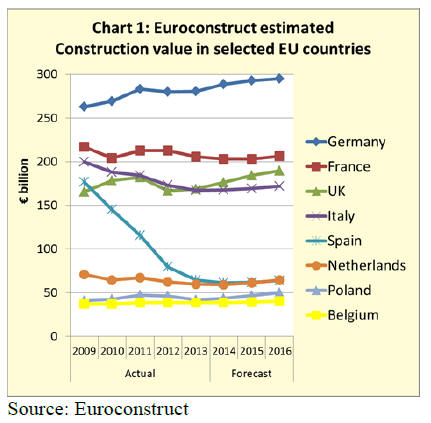
Much of the growth in European construction will be
concentrated in new residential construction, but the
gradual recovery should feed through into all sub sectors.
New residential construction in total is expected to grow
by 3.2% a year between 2014 and 2016.
However residential renovation and maintenance (R&M)
is expected to grow by only 1.2% a year. This will reduce
average growth in total residential construction to 2% a
year in real terms.
Although most EU countries are clear of recession,
sluggish domestic demand growth and weak public sector
finances are likely to dampen non-residential construction
for some time. Euroconstruct expect total non-residential
construction on average to increase by 1.5% a year
between 2014 and 2016 in real terms, an upward revision
of 0.3% from the November 2013 forecast.
Total civil engineering works is now expected to grow by
1.9% a year between 2014 and 2016 in real terms,
compared to 1.5% in the previous forecast. The adjustment
is mainly a result of a brighter outlook for new civil
engineering.
European ¡¯real wood¡¯ flooring production down 1.8% in
2013
Production of „real wood‟ flooring 1 in the 17 countries
covered by FEP2, the European wood flooring association,
declined by 1.8% to 67.03 million m2 in 2013 (Chart 2).
FEP estimate that total production in Europe, including
both FEP and non-FEP countries, was just over 77 million
sq.m in 2013. These figures were released by FEP at their
annual meeting in Malaga, Spain, in June.
1 The term „real wood‟ flooring is used to denote products
with a real wood face veneer which are identified
specifically as wood flooring in the trade product codes.
These products are distinct from laminated flooring which
are considered separately in this report.
2 Austria, Belgium, Czech Republic, Denmark, Finland,
France, Germany, Hungary, Italy, Netherlands, Norway,
Poland, Romania, Slovakia, Spain, Sweden and
Switzerland.
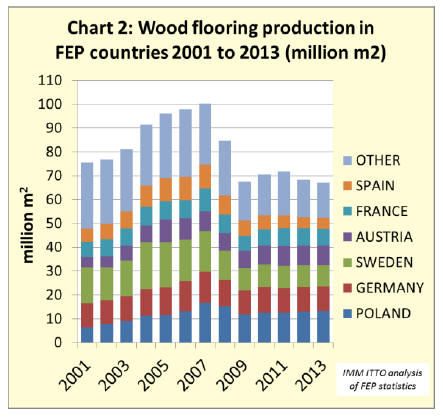
Production in Poland, Europe‟s largest wood flooring
manufacturing country, increased 2.5% to 13.28 million
sq.m in 2013. Poland now accounts for nearly 20% of all
production in FEP countries.
Production in Germany, the second largest European
manufacturing country, remained stable at 10.4 million m2
between 2012 and 2013.
However production in Sweden, the third largest
manufacturing country, declined 3.3% to 8.78 million
sq.m in 2013. There was also a 5.8% fall in production in
France to 6.9 million sq.m.
There was no change in the proportion of real wood
flooring production by product type between 2012 and
2013 (Chart 3). In both years, multilayer flooring
accounted for 78% of production, solid wood for 20% of
production and mosaic wood flooring for only 2% of
production.
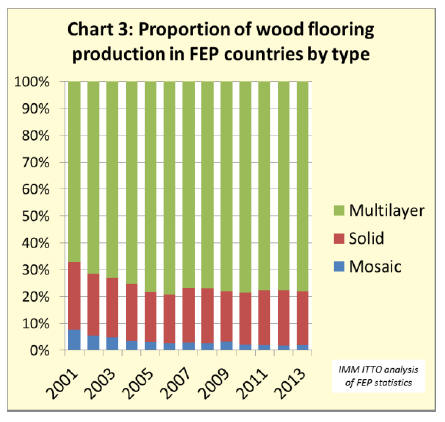
Consumption of real wood flooring in FEP countries
declined 2.6% to 82.68 million sq.m in 2013 (Chart 4).
Consumption in all the leading European markets was
falling last year.
Consumption was down 6% to 19.8 million m2 in
Germany, down 7% to 11.6 million m2 in France, and
down 5% to 7.8 million m2 in Italy.
However these losses were partially offset by rising
consumption in Austria, Denmark, Finland, Norway,
Switzerland, and Romania.
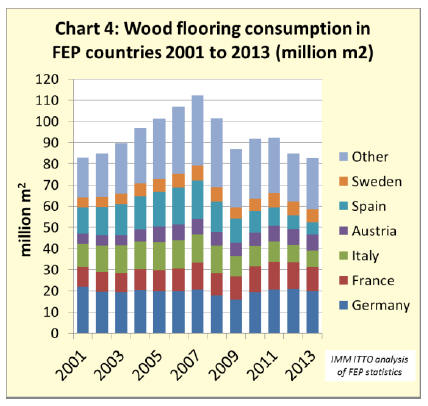
Consumption of real wood flooring per inhabitant
throughout the FEP area fell slightly from 0.22 sq.m in
2012 to 0.21 sq.m in 2013. Per capita consumption is now
highest in Switzerland (0.79 sq.m), followed by Austria
(0.77 sq.m) and Sweden (0.65 sq.m).
In contrast, per capita consumption was no more than 0.05
sq.m in Netherlands and Hungary.
The dominance of oak in European real wood flooring
production continued to rise last year, while tropical wood
lost more ground (Chart 5). In 2013, oak accounted for
70.9% of wood flooring production in FEP countries, up
from 69.6% in 2012.
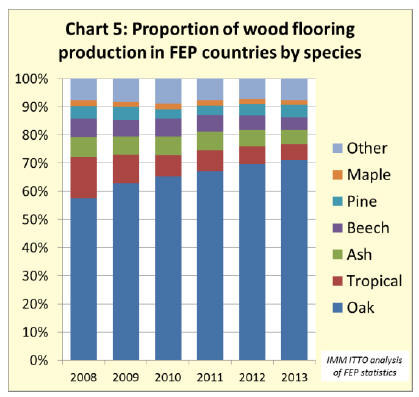
The share of tropical wood fell from 6.2% to 5.8% last
year. The share of ash (5.1%), beech (4.6%) and maple
(1.6%) were all slightly lower in 2013 than in the previous
year. However, the share of pine increased from 4.1% in
2012 to 4.4% in 2013.
At their June meeting, members of FEP reported that the
outlook for real wood flooring in Europe has improved in
2014 after nearly seven years of lingering economic and
financial crisis.
The positive trends that have emerged in northern Europe
at last seem to be filtering through into southern Europe
which was traditionally a large market for wood flooring.
However, members of FEP expressed concern about
continuing lack of access to credit following the financial
crises, particularly amongst small and medium-sized
companies that dominate the wood flooring sector.
Slowdown in rate of increase in EU wood flooring
exports
EU exports of real wood flooring have been rising in
recent years as European manufacturers focused on
diversifying overseas markets in the face of weak
domestic demand.
In 2013, around 25% of all real wood flooring
manufactured in the EU was exported to non-EU
countries. However the pace of increase in exports slowed
in the first four months of 2014 with a slowdown in
economic growth and political problems in several major
external markets.
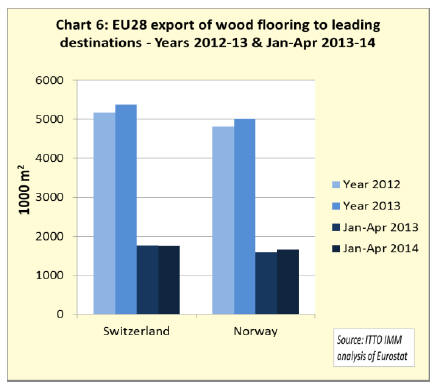
Total EU exports of wood flooring increased 4.7% to
17.78 million m2 between 2012 and 2013. There was
growth in exports to Switzerland and Norway, by far the
largest export destinations (Chart 6).
However there was also significant growth in exports to
USA, Turkey, Ukraine, China and Hong Kong in 2013
(Chart 7).
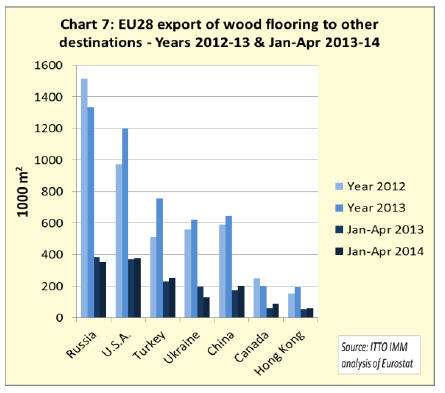
Between January and April 2014, the EU exported 5.64
million m2 of wood flooring, 1.3% more than the same
period in 2013. This year exports have continued to rise
strongly to Norway, Turkey, China and Hong Kong.
However the rate of export growth has slowed to the USA,
while exports to Switzerland and Ukraine have been
declining in 2014. Exports to Russia began to decline in
2013 and this trend has continued in 2014.
Partial recovery in EU wood flooring imports from
China
Imports of „real wood‟ flooring from outside the EU
supply around 22% of total consumption throughout the
region. EU imports of real wood flooring declined 14%
from 23.1 million m2 in 2012 to 19.8 million m2 in 2013.
Imports from China, by far the largest external supplier,
fell 15% from 15.4 million m2 in 2012 to 13.0 million m2
in 2013 (Chart 8).
This was due to the combined effects of very slow
construction activity and consumer demand in Europe,
competition from Europe‟s domestic manufacturers and
alternative flooring products, rising costs in overseas
manufacturing locations, and diversion of supply to more
dynamic emerging markets.
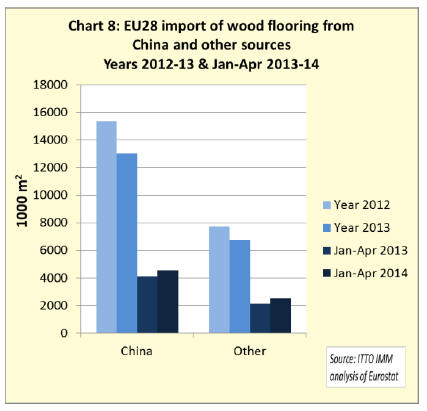 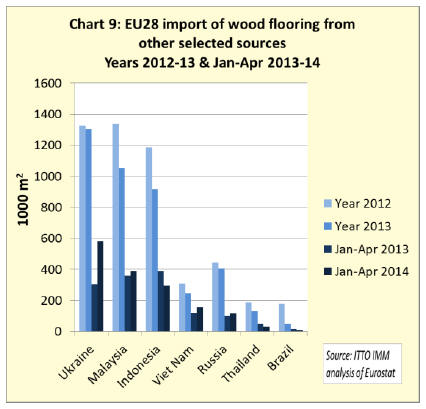
However EU imports of real wood flooring have been
rising again this year. Between January and April 2014,
the EU imported 7.1 million m2 of real wood flooring,
13.2% up on the same period in 2013.
Imports from China were 4.6 million m2 in the first four
months of 2014, 11% more than in the same period the
previous year.
Imports have also risen from Ukraine, Malaysia, Vietnam
and Russia this year. Imports from Indonesia and Thailand
have continued to decline (Chart 9).
European laminate flooring manufacturers report slow
recovery
Europe‟s laminate flooring sector, while still dominant in
global terms, came under considerable pressure during the
global financial crises. Declining consumption combined
with overcapacity and overseas competition, particularly
from China, led to a sharp fall in prices.
This meant that retailers had to shift huge volumes of
laminate flooring in order to profit from sales. As a result
distributors have been turning to higher margin products
such as Luxury Vinyl Tiles (LVT) which are seen to offer
a better combination of quality, value and margin.
The European laminate flooring industry has responded
partly through down-sizing and partly through
development of new higher value product lines. It has also
focused marketing efforts on the specific performance and
environmental benefits of laminate flooring and on the
quality credentials of European manufacturers.
Partly as a result of these efforts, Europe‟s laminate
flooring market has become increasingly diversified. Low
end products are still available at retail prices of less than
€10 per m2. These contrast with upscale products offering
some combination of long-life guarantee, bevelled edges,
handscraping, wire brushing and exotic designs which
might be priced in excess of €25 per sq.m.
The industry‟s marketing effort has been co-ordinated by
the Association of European Producers of Laminate
Flooring (EPLF) which this year incorporated the slogan
¡°Quality and Innovation made in Europe¡± into the
association logo.
EPLF's members currently consist of 21 manufacturers
from 11 European countries. The EPLF manufacturers
supply approximately 55% of the global laminate flooring
market and over 80% of the European market.
Germany is hugely dominant in the sector in Europe,
accounting for around 50% of production by EPLF
members in 2013. The second largest producer amongst
EPLF members is Turkey accounting for 15% of
production.
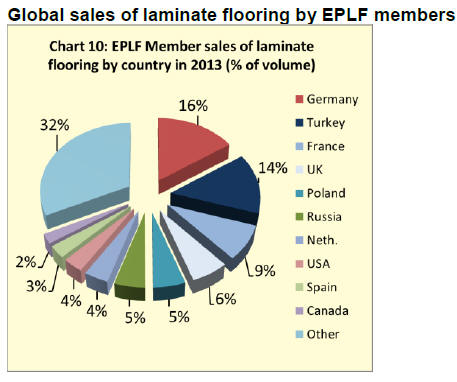
According to the latest EPLF annual report, the European
market for laminate flooring has stabilised and is just
beginning to show signs of recovery. Sales of laminate
flooring by EPLF member companies increased 0.7%
from 460m sq.m in 2012 to 463m sq.m in 2013.
Although sales declined in Western Europe and Turkey in
2013, there were gains in other regional markets (see
table).
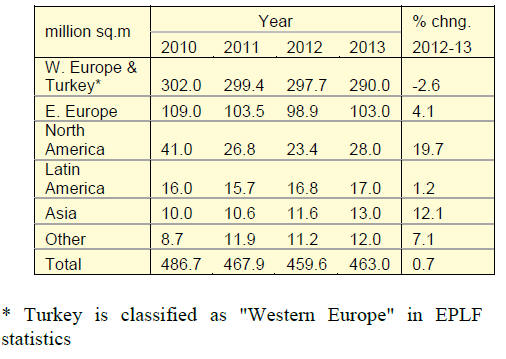
Sales of laminate flooring in Germany, the largest single
European market for laminate flooring, fell from 76
million sq.m in 2012 to 72 million sq.m in 2013. Sales in
Turkey, the second largest market, declined from 66
million sq.m in 2012 to 65 million sq.m in 2013.
France also saw a slight decline from 40 million sq.m in
2012 to 39m sq.m in 2013. Sales to the UK were stable at
29 million sq.m in 2012 and 2013.
EPLF member sales increased in Eastern Europe in 2013.
Poland was the largest market for laminate flooring in the
region, with sales rising from 24 million sq.m in 2012 to
25 million sq.m in 2013. Sales also increased in Russia,
Romania and Ukraine last year.
As recently as 2011, North America experienced a
dramatic slump in sales of laminate flooring due to the
challenging economic situation in the USA. Sales dropped
from 41 million sq.m in 2010 to 27 million sq.m in 2011
and then to only 23 million sq.m in 2012.
In 2013, North American sales picked up once more,
rising to 28 million sq.m. Sales in the USA increased from
12 million sq.m in 2012 to 16 million sq.m in 2013. Sales
in Canada remained stable at 11 million sq.m in both 2012
and 2013.
Tough competition from Asia‟s domestic manufacturers
has meant that sales of European laminate flooring to the
region have been limited to date. European sales are
focused on higher value premium products. European
sales throughout Asia increased from 11.6 million sq.m in
2012 to 13 million sq.m in 2013.
European sales of laminate flooring in China, including
Hong Kong, increased from 3 million sq.m in 2012 to 4
million sq.m in 2013.
The volume is very small compared with the overall size
of the Chinese market which is believed to consume in
excess of 250 million sq.m of laminate flooring each year.
Challenges to European laminate flooring in Turkey
and Russia
EPLF members report a slight upward trend in total
European sales of laminate flooring in the first half of
2014.
However political issues are now creating concerns about
future prospects in Turkey and Russia which have been
key growth markets for laminate flooring in recent years.
Sales of European laminate flooring in Turkey weakened
in the first half of this year. This was partly driven by a big
fall in the value of the lira-euro exchange rate. However it
may also be a consequence of Turkey's decision in
December 2013 to start anti-dumping procedures against
German laminate flooring producers.
The decision follows complaints by Turkish flooring
producers that German manufacturers have been selling at
below production cost in Turkey. German manufacturers
have responded that their costs are lower than Turkish
competitors because they have more efficient raw material
supply chains. The Turkish government is still
investigating and has yet to publish a final decision.
EPLF members also report challenges in the Russian
market this year. Apart from the potential political fall-out
from recent events in Ukraine, European laminate flooring
manufacturers allege widespread counterfeiting of their
products in the Russian market.
EPLF claim that in Russia ¡°the high proportion of inferiorquality
and incorrectly-declared goods imported from Asia
makes things difficult for EPLF manufacturers as it tends
to cause lasting damage to the image of laminate
flooring¡±. To counter this threat, EPLF has established a
"Russia task force" to work directly with Russian trade
associations and retailers to raise awareness of quality
standards and put in place procedures for brand protection.
European laminate flooring follows fashion for oak and
rusticity
EPLF report that "rusticity" remains the key theme in
current laminate flooring ranges in Europe. The rustic
"used look" appears in several varieties of products, from
construction timber styles with imitation cement traces, to
flooring that feels brushed, planed or freshly sanded.
Ultra-modern synchro-pore printing now enables more
authentic transfer of a wide variety of structures, from fine
veins and pores to deep, distinctive knots. There is still a
strong preference for larger and wider sized boards.
Oak continues to dominate wood decors with its wideranging
decorative potential, from white-washed to
smoked. However floors with the appearance of
delicately-grained ash, walnut or elm, or rich softwoods
such as spruce and larch, are also rapidly gaining in
popularity.
A considerable amount of laminate wood decor no longer
appears in its "natural" version, but rather with a discreet
white or grey haze.
Dark colours have seen a slight decline, with the new
floors of European laminate manufacturers instead
presenting a varied spectrum of natural grey and beige
tones.
This follows a trend that originated in the wider field of
interior decoration.
* The market information above has been generously provided by the
Chinese Forest Products Index Mechanism (FPI)
|